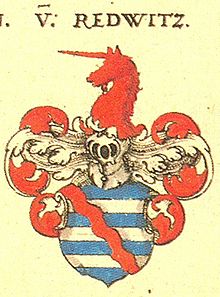Windischeschenbach Castle

The expired Windischeschenbach Castle was the seat of the court of the Upper Palatinate town of Windischeschenbach . The castle burned down in 1810 and was no longer rebuilt.
history
Windischeschenbach was first mentioned in 1230, when Marquard von Redwitz was enfeoffed by the Landgraves von Leuchtenberg . The fiefdom was a male and female fief . The fortress was located as a pond castle on the right side of the Waldnaab or near the Rumpelbach , where the ponds on Dammstraße still remind of this building. One should not think of a stone castle , but possibly a wooden moth that was erected on a small hill. This Weiherburg, enclosed by a dam, was abandoned in 1697 by Freiherr Wilhelm Johann von Herding , who built a new castle about 300 m southeast of it. This facility is now designated as an archaeological monument under the name Burgstall Windischeschenbach .
In 1459 the Hofmark passed to the Lords of Leyneck and shortly afterwards to the Lords of Tettau . In 1503 Balthasar von Tettau sold the Hofmark to Wilhelm Schenk von Trautenberg . From the mid-1520s his heirs are named here, who divided the property among themselves. In 1533 a daughter of Wilhelm , who was then married to Christoph Löneiß , owned three parts of the Hofmark, which were then passed on to her husband. In 1540, a reverse letter was issued for Karl Schenk von Trautenberg's minor race covering a fifth of the property, and in 1544 Christoph Löneiß was the sole owner of the Hofmark. Christoph Steinrucker was here between 1545 and 1550 , then a wolf named Karl von Trautenberg , who died around 1572 and was followed by Friedrich von Trauttenberg († 1580), Archbishop of Utrecht.
From 1579 the Hofmark was under the administration of Johann Orth , the Leuchtenberg monastery judge of Neuhaus . In 1590 he was commissioned to regulate the ownership structure between the brothers Joachim , Stephan and Oswald von Potzlarn in the Netherlands . Andreas Jan was employed as administrator and judge for the absent Hofmark owners. In 1615 the Potzlarn brothers were enfeoffed again with the Hofmark. On June 5, 1617, a fiefdom lapel was issued for Rüdiger von Potzlarn the Younger on Neuen Tautenburg . A few years later, the estate manager Andreas Jan accepted the fiefdom lapel for Jovian von Potzlarn . Andreas Jan was murdered on June 29, 1632 by soldiers from Wallenstein . His son Lorenz Jan became his successor as administrator . Shortly after the end of the Thirty Years' War , Heinrich Florian von Potzlarn became the owner of the Hofmark.
In 1671 Baron Wilhelm von Herding zu Hiltrup acquired the Hofmark. At that time, the Hofmark in Windischeschenbach included 44 properties with 57 families, then two properties in the village of Pleisdorf , which belongs to Waldsassen , then the Oberbaumühle and eleven estates from Gleißenthal . On February 29, 1720, Wilhelm Johann von Herding and his brother Ernst Melchior were appointed as court lords . He was succeeded by Casimir von Herding , Herr zu Hiltrup and Windischeschenbach, Lieutenant General and Chief Chamberlain to Her Majesty the Queen Karoline of Bavaria, Knight of the Order of Hubert , holder of the Grand Cross of the Westphalian Crown and Knight of Malta . He died in Munich on October 1, 1811.
On February 17, 1810, the castle and its farm buildings were burned to rubble and ashes. The underage son Maximilian von Herding , who later lived in Mannheim , came under the supervision of his mother, Countess Saint Martin , who was supported in the management by Fiscal Council Baron von Hillesheim . The owners refused flimsy explanations that in 1810 paid out fire insurance of 900 fl to be used for the reconstruction of the castle. After an intervention by the Bavarian king in 1846, they were even allowed that the castle no longer had to be rebuilt, but the money was to be used for the Hofmark, something the owners, who lived far away, were not willing to do either. The landowner Joseph Eckert from Plößberg bought the estate and the farm building, who erected a two-story building in the castle courtyard in 1856 (today Schlosshof 13); even his efforts to get the fire sum paid out were unsuccessful.
Maximilian von Herding died childless in 1851, the inheritance came to his sister Maria Magdalena von Herding , widowed Princess of Ysenburg - Birstein and was allodified on August 14, 1851 in return for a transfer fee .
literature
- Hauser, Georg: Home book of the city Windischeschenbach. City of Windischeschenbach 1991.
- JB Lehner: From the Urmeierhof to the industrial city. Windisch-Eschenbach's political and economic development. In commemorative publication for the millennium of the city of Windisch-Eschenbach: from July 12 to July 20, 1952. pp. 20–26. Oberpfälzer Nachrichten, Weiden 1952.
Individual evidence
- ↑ Heribert Sturm : Old Bavaria I Neustadt an der Waldnaab - Weiden. Windischeschenbach . Ed .: Commission for Bavarian State History (= Historical Atlas of Bavaria, Issue 47 ). Munich 1978, ISBN 3-7696-9912-2 , p. 244 , above ( digitized version [accessed January 20, 2020]).
Coordinates: 49 ° 48 ′ 5.5 ″ N , 12 ° 9 ′ 11.6 ″ E

